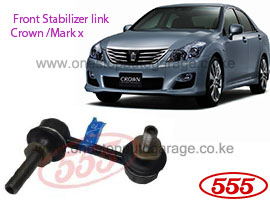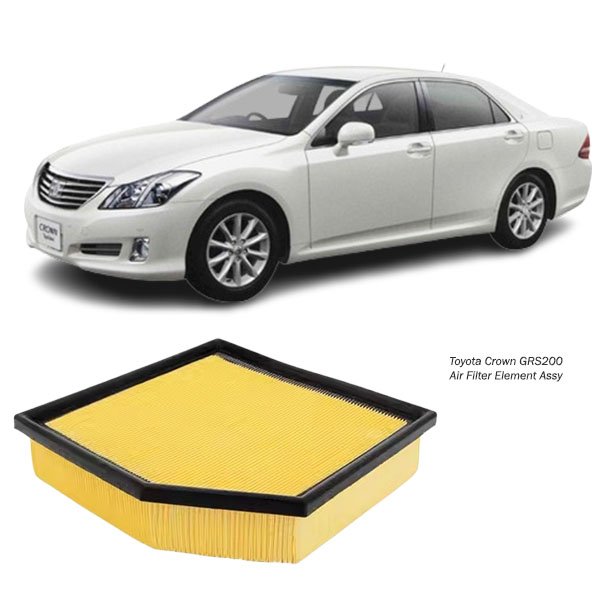-20%
Get Toyota Crown GRS200 Air Filter Element Assy 17801-31100in Kenya
The air filter element assembly is a vital component in your vehicle’s engine air intake system. Whether you drive a Toyota Prado 120/150, Nissan Note, Wingroad, Tiida, or any other vehicle, the air filter plays a crucial role in keeping your engine clean and efficient.
A clogged or dirty air filter can lead to poor engine performance, reduced fuel efficiency, and even engine damage. In this guide, we will cover what an air filter element assembly does, why it’s important, signs of failure, types of air filters, maintenance tips, and how to replace it.
What Is an Air Filter Element Assembly? 🤔
The air filter element assembly is a replaceable filtration component that sits inside the air intake system. Its job is to trap dust, dirt, pollen, and other contaminants before they enter the engine.
Main Functions:
🔹 Filters Out Dirt & Debris – Prevents harmful particles from entering the engine.
🔹 Ensures Clean Air Intake – Provides optimal air-fuel mixture for combustion.
🔹 Improves Engine Efficiency – Enhances fuel combustion and power output.
🔹 Increases Engine Lifespan – Reduces wear on engine components.
Without a clean air filter, your engine could suffer from contaminant buildup, leading to poor fuel economy, misfires, and excessive emissions.
How Does an Air Filter Element Work? ⚙️
Your vehicle’s air intake system pulls in air from the surroundings. The air filter element assembly sits between the air intake and throttle body, ensuring only clean air enters the engine.
Airflow Process:
1️⃣ Air is drawn into the intake system – Through the front grille or air duct.
2️⃣ Air passes through the air filter – The filter captures dirt and dust particles.
3️⃣ Filtered air enters the engine – Mixing with fuel for combustion.
If the air filter is clogged, airflow is restricted, leading to engine inefficiency and increased fuel consumption.
Types of Air Filters 🔧
There are different types of air filters available, each with unique benefits:
1️⃣ Paper Air Filters (OEM Standard)
✔️ Most common in factory-installed filters
✔️ Made of pleated paper or fabric
✔️ Efficient at trapping dirt and debris
✔️ Affordable but requires frequent replacement
2️⃣ Foam Air Filters
✔️ Used in off-road and performance vehicles
✔️ Washable and reusable
✔️ Good at trapping larger particles
✔️ Requires regular oiling to work effectively
3️⃣ Cotton Gauze (High-Performance Filters)
✔️ Found in aftermarket performance filters
✔️ Improves airflow and horsepower
✔️ Reusable and long-lasting
✔️ More expensive than standard filters
4️⃣ Carbon or Activated Charcoal Filters
✔️ Removes odors and harmful gases
✔️ Often used in luxury and hybrid vehicles
✔️ Helps improve cabin air quality
For Toyota Prado 120/150, Nissan Note, Wingroad, and Tiida, a standard OEM paper air filter is the best option for daily driving, while a cotton or foam filter may be better for performance or off-road use.
Why Is an Air Filter Important? 🚘
Your engine needs clean air for proper combustion. If the air filter is dirty or clogged, it can lead to several issues, including:
❌ Reduced Engine Power – Less air means inefficient combustion.
❌ Poor Fuel Economy – The engine burns more fuel to compensate.
❌ Increased Emissions – Affects exhaust gas quality.
❌ Engine Wear & Tear – Dirt and debris can damage internal parts.
❌ Check Engine Light Activation – A clogged filter can trigger warning lights.
Replacing the air filter at the recommended intervals ensures optimal performance and engine longevity.
Signs of a Dirty or Failing Air Filter 🚨
Over time, dust, dirt, and debris accumulate in the air filter, reducing its efficiency. Here are some common signs that it’s time to replace your air filter element assembly:
🔧 Reduced Acceleration or Power – The engine struggles to breathe.
⛽ Poor Fuel Economy – More fuel is burned due to insufficient air.
💨 Black Smoke from Exhaust – Indicates incomplete combustion.
🚗 Engine Misfires or Rough Idling – Caused by an improper air-fuel mixture.
⚠️ Check Engine Light Turns On – A clogged filter may trigger a sensor warning.
🌫️ Unusual Engine Sounds – Whistling or coughing noises from the intake system.
If you notice any of these symptoms, check your air filter and replace it if necessary.
How to Replace an Air Filter Element Assembly – Step-by-Step Guide 🛠️
Replacing an air filter element is one of the easiest car maintenance tasks. It usually takes 5-10 minutes and requires no special tools.
Tools Needed 🧰
✔️ New air filter (OEM or aftermarket)
✔️ Screwdriver (if required for the airbox)
✔️ Clean rag (for wiping the airbox)
Installation Steps 🔩
1️⃣ Turn Off the Engine – Ensure the car is completely off.
2️⃣ Locate the Air Filter Housing – Typically found near the engine.
3️⃣ Open the Air Filter Box – Use clips or screws to remove the cover.
4️⃣ Remove the Old Air Filter – Check for dirt and debris.
5️⃣ Clean the Airbox – Wipe away dust and dirt.
6️⃣ Install the New Air Filter – Make sure it fits securely.
7️⃣ Close the Air Filter Box – Secure all clips or screws.
8️⃣ Test the Engine – Start the car and check for smooth airflow.
💡 Tip: Always use the recommended air filter for your vehicle to maintain optimal performance.
OEM vs Aftermarket Air Filters 🏁
When replacing your air filter element, you have two options:
🔹 OEM (Original Equipment Manufacturer):
✔️ Designed specifically for your vehicle
✔️ Ensures proper fit and filtration
✔️ More expensive but highly reliable
🔹 Aftermarket Air Filters:
✔️ Available in different materials (cotton, foam, etc.)
✔️ Some offer better airflow and horsepower gains
✔️ Quality varies – choose trusted brands
For Toyota Prado 120/150, Nissan Note, Wingroad, and Tiida, OEM air filters are best for reliable daily performance, while performance air filters can enhance power and efficiency.
Maintenance Tips for a Long-Lasting Air Filter 🏎️
To keep your air filter in top condition, follow these maintenance tips:
✅ Inspect the Air Filter Every 10,000 – 15,000 km – Check for dirt and damage.
✅ Replace the Air Filter Every 20,000 – 40,000 km – More often in dusty environments.
✅ Keep the Air Intake Area Clean – Prevents dirt buildup.
✅ Use High-Quality Air Filters – Cheap filters can damage your engine.
✅ Consider a Performance Filter If Needed – For better airflow and longevity.
A clean air filter ensures better fuel economy, engine power, and long-term reliability.
Common Questions About Air Filters 🤔
1️⃣ How often should I replace my air filter?
Every 20,000 – 40,000 km, or sooner in dusty areas.
2️⃣ Can a dirty air filter cause engine damage?
Yes! Clogged filters can lead to misfires, poor combustion, and increased wear.
3️⃣ Do performance air filters increase horsepower?
Yes, but usually only by 1-5 HP in normal vehicles.
4️⃣ Can I clean and reuse my air filter?
Only if it’s washable (foam or cotton filters). Paper filters must be replaced.
Final Thoughts 💭
The air filter element assembly is a simple yet essential part of your vehicle. Keeping it clean and well-maintained ensures better engine performance, fuel efficiency, and longevity.
Follow us on Facebook for more parts.



